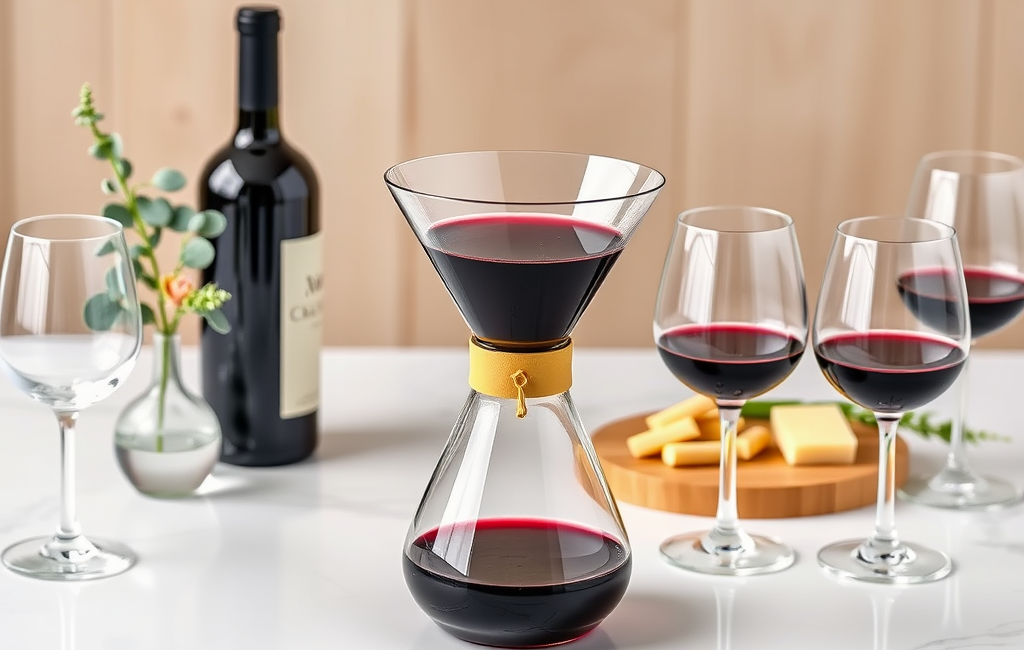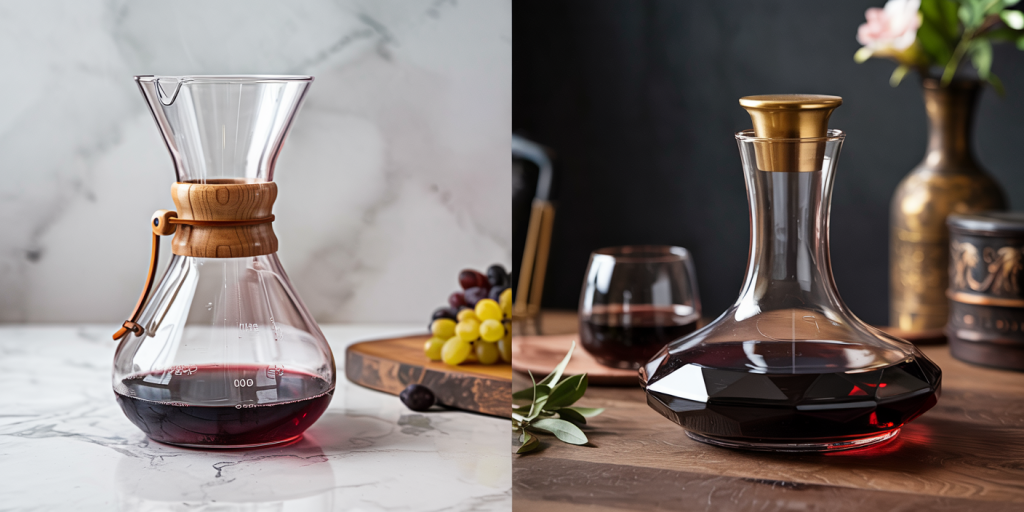This post may contains affiliate links. Read our full disclosure here.
So last weekend, my boyfriend and I were getting ready for a last-minute dinner party when disaster struck – I couldn’t find my wine decanter anywhere! With a bottle of particularly tannic Cabernet Sauvignon waiting to breathe and guests arriving in an hour, I spotted our Chemex coffee maker sitting innocently on the counter. That’s when I had what might be my most questionable (or brilliant?) wine moment of 2025: could I actually decant wine in a Chemex?

Spoiler alert: I did it, and it wasn’t half bad! This coffee-wine crossover experiment got me curious about whether this was actually a legitimate hack or just a desperate move. After some research and more “testing” (you know, for science), I’ve got answers about decanting wine in a Chemex – the good, the bad, and everything in between. Let’s break down what happened when I merged my coffee gadget with my wine hobby!
The Quick Answer: Yes, You Can Decant Wine in a Chemex!
Let’s cut to the chase – yes, your Chemex can double as a wine decanter in a pinch! The hourglass shape actually works similarly to a traditional decanter, giving wine the surface area it needs to interact with oxygen. It’s not going to replace a proper decanter for serious wine lovers, but for casual drinking? It’s a perfectly acceptable substitution when you’re in a jam.
The Chemex’s design actually offers decent aeration for younger, more tannic wines that benefit from some oxygen exposure. Plus, that iconic wooden collar and minimal aesthetic make it look pretty darn stylish on your counter – much nicer than that plastic funnel I almost used in desperation!
That said, this hack works best for younger, full-bodied red wines like Cabernet Sauvignon, Syrah, and Malbec that could use a little softening. For delicate whites or precious aged bottles? Maybe stick with traditional methods. Wine aging significantly affects flavor profiles, so older wines with sediment require more careful handling than this coffee maker can provide.

Why a Coffee Maker Actually Works for Wine (Sort Of)
I realize using a coffee maker for wine sounds a bit like using your hairdryer as a toaster – technically possible but probably not recommended. However, the Chemex’s design has some surprisingly wine-friendly features that make this weird hack work better than you’d expect.
First, that wide bottom basin allows wine to spread out and make contact with air – exactly what you want for aeration. The narrow neck serves a similar purpose to a decanter, controlling the flow of oxygen while providing a convenient pour spout. Even the hourglass shape isn’t too far off from many traditional decanters.
The main difference? Traditional decanters are designed specifically for sediment separation and optimal aeration. The Chemex was designed to filter coffee grounds and manage water flow. So while there’s functional overlap, they’re still tools made for different jobs. But when your wine is young and just needs some quick oxygen exposure, the Chemex can actually do a pretty decent job.

Step-by-Step: How to Actually Pull Off This Hack
Ready to try this wine hack yourself? Here’s my tried-and-tested method for using a Chemex as a wine decanter without ruining your bottle or your coffee maker:
1. Skip the filter paper – While Chemex filters are perfect for coffee, they can actually filter out desirable compounds in wine. Unless your wine is extremely harsh and young (in which case a slight filtering might help), go filterless for best results.
2. Clean your Chemex thoroughly – This might seem obvious, but any coffee residue will absolutely ruin your wine experience. Run it through the dishwasher or hand wash with unscented soap, then rinse thoroughly and let it dry completely.
3. Pour gently down the side – Unlike with coffee brewing, you want to minimize splashing and turbulence. Pour your wine slowly down the inner wall of the Chemex to prevent over-oxidation or foaming.
4. Let it breathe – Give the wine 10-20 minutes in the Chemex. The wide bottom allows for good air contact, which helps develop those complex wine aromas faster than if you just opened the bottle.
5. Serve directly from the Chemex – One of the coolest parts of this hack is that the Chemex doubles as a serving vessel with its comfortable wooden collar. It makes for a great conversation piece at dinner parties!

Which Wines Work Best With This Hack?
Not all wines will benefit equally from the Chemex treatment. From my experiments (and a few happy accidents), here’s what worked well and what definitely didn’t:
Perfect Candidates:
- Young, tannic red wines (less than 5 years old)
- Full-bodied Cabernet Sauvignon, Syrah, Malbec, and Tempranillo
- Value-priced bottles that taste a bit tight or closed when first opened
- Wines you’re serving in smaller quantities (the Chemex is perfect for 1-2 people)
Skip This For:
- Aged wines with significant sediment
- Delicate whites and rosés (they rarely need much decanting anyway)
- Sparkling wines (you’ll lose all those precious bubbles!)
- Expensive, special occasion bottles (why risk it?)
The general rule: the more robust and youthful the wine, the better it will handle the Chemex treatment. For those special bottles, you might want to invest in proper wine gear instead. After all, the right glassware makes a noticeable difference in your wine experience.

The Science: Does This Actually Work or Is It Just Pretty?

For the skeptics out there (I was one too!), let’s talk about the actual science behind decanting and why this coffee-maker hack isn’t completely ridiculous. When you decant wine, you’re accomplishing two primary things: exposing wine to oxygen and separating it from sediment.
A 2018 study published in the Journal of Agricultural and Food Chemistry confirmed that proper aeration helps soften tannins and release volatile aromatic compounds – that’s why your red wine often tastes better after breathing. The Chemex’s wide bottom provides excellent surface area for this aeration process.
What the Chemex lacks, however, is the gentle curve and pour design that helps keep sediment from older wines at the bottom while you pour. That’s why this hack works better for younger wines without much sediment. The Chemex also doesn’t have the optimal glass thickness and crystal clarity that high-end decanters offer, which can affect temperature maintenance and visual assessment.

If you’re curious about how wine aeration works on a molecular level, it’s pretty fascinating stuff. Oxygen interacts with wine’s phenolic compounds, softening astringency and allowing more flavors to emerge for better food pairing potential. It’s like giving your wine a chance to stretch after being cooped up in the bottle!
Alternative Wine Hacks When You’re Short on Equipment

While the Chemex hack is my personal favorite for its style points, there are several other ways to improvise when you’re lacking proper wine tools. Here are a few alternatives that actually work:
The Blender Method – Yes, you read that right. Some wine experts actually recommend giving young, tannic red wine a quick 30-second spin in a blender to “hyperdecant” it. It sounds sacrilegious, but the science checks out – it’s just high-speed aeration. I’d only try this with sub-$20 bottles though!
The Mason Jar Transfer – Pour wine between two mason jars a few times to introduce oxygen. It’s not elegant, but it effectively aerates in a pinch. This method works particularly well for budget reds that need opening up quickly.
Wine Aerator Attachments – If you’re tight on storage space in your apartment, good wine storage solutions can be challenging. A small aerator attachment that fits directly into the bottle neck takes up minimal space and works surprisingly well.
The Decanter Carafe Hybrid – Water carafes can double as wine decanters. They usually have a wide enough base for decent aeration and look pretty on the table. Just make sure it’s clean and free of any soap residue before using.
My Final Take: A Fun Hack Worth Trying
After multiple tests (and many glasses of wine), my verdict on the Chemex-as-decanter hack is pretty positive. It’s not going to replace a proper decanter for serious wine enthusiasts, but it’s a perfectly serviceable solution that happens to look pretty darn chic on your counter.

The best part? Most of us don’t have room for a dozen single-purpose wine gadgets in our kitchens. Having tools that can pull double-duty makes practical sense, especially in smaller living spaces. Plus, there’s something satisfying about repurposing what you already have rather than buying more stuff.
Would I use a Chemex for a precious bottle of aged Bordeaux? Absolutely not. But for that $15 Malbec that needs to breathe before Tuesday night dinner? It’s perfect. Next time you’re stuck without a decanter, give this hack a try – and tag me in your wine pics! I’d love to see what bottles you’re experimenting with.
The bottom line is that wine should be fun, not intimidating. Whether you’re using specialized equipment or MacGyvering a solution with what you have on hand, what matters most is that you’re enjoying the experience. So pour, sip, and savor – even if your decanter started its life as a coffee maker!




